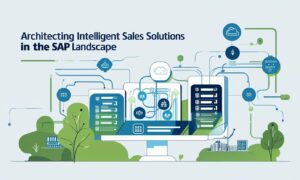Interviewer: Good morning, Narasimha. First off, let’s highlight the elephant in the room – your expansive list of accolades. As an SAP Champion, you are one of a mere 80+ among the 3.5 million unique visitors on community.sap.com, listed among the top 4 influencers in manufacturing, and awarded ‘Best IT Blogger – 2023’. And, if that wasn’t enough, you’ve also been honored as one of the “Most Admired Global Indians-2023”. What’s the secret sauce behind your dedication and passion for SAP?
Narasimha Prasad Bhat: Thank you for acknowledging my efforts. My journey with SAP is a tale of constant learning and understanding the intricate workings of businesses globally. Every organization I’ve worked with has a unique set of challenges, and SAP offers the tools to address these. My motivation stems from this transformative potential and the impact it has on industries.
Interviewer: With Predictive Material and Resource Planning (pMRP) being a buzzword today, could you offer our readers a brief introduction?
Narasimha Prasad Bhat: Absolutely. Imagine a scenario where your production planning tool not only helps manage current processes but also anticipates potential challenges and offers solutions even before they arise. That’s pMRP for you – a foresight tool, a visionary approach to handling resources and materials within SAP.
Interviewer: Traditionalists often swear by the SAP Long-Term Planning (LTP). How does pMRP redefine this approach?
Narasimha Prasad Bhat: LTP, no doubt, was a game-changer in its era. However, the business landscape is evolving rapidly. pMRP brings agility, seamless integration with the SAP Fiori Apps, and the luxury of simulating various scenarios without the hassles of extensive customization. It’s like comparing a classic car with a modern electric vehicle. Both have their charm, but the latter is more aligned with today’s needs.
Interviewer: In the grand scheme of things, what prompted SAP to birth pMRP?
Narasimha Prasad Bhat: The writing was on the wall. With markets becoming increasingly volatile and customer demands getting intricate, businesses were seeking a tool that didn’t just react but proactively predicted challenges. SAP’s pMRP is an answer to this demand, designed for real-time adaptability.
Interviewer: I’m sure many of our readers would love a concise guide to maximizing pMRP. Could you walk us through?
Narasimha Prasad Bhat: With pleasure:
- Data Setup: The bedrock of any system is its data. Ensure you have well-defined materials, bills, work centers, routings, and production versions.
- Transactional Data Entry: Populate the Planned Independent Requirements, which act as the blueprint for your simulations.
- Fiori Apps Navigation: Utilize specific apps such as
– Schedule pMRP simulation creation.
– Process pMRP Simulations.
– Process pMRP Capacity Simulations.
- Draft a Demand Plan: This is your prediction chamber. Chart out anticipated needs for a period, say, the upcoming month.
- Execute Simulations: Enter the sandbox. Confront challenges, experiment with solutions, refine, and repeat.
- Resolve Challenges: Innovate. Maybe you need to switch your source of supply, rejig preproduction schedules, or modify available capacity.
- Finalize: Once you’re convinced of your simulation’s effectiveness, carve it in stone.
Interviewer: Having seen many businesses in action, are there any typical pMRP pitfalls they should sidestep?
Narasimha Prasad Bhat: An astute observation. Firstly, businesses often underestimate the importance of the initial data setup, which can be detrimental. Secondly, the dynamic nature of markets demands regular simulation updates. Being complacent here can lead to misjudgments. Lastly, while pMRP is intuitive, it’s essential to invest in team training to harness its full breadth.
Interviewer: Real-world examples often resonate best. Can you recall an instance where pMRP turned the tables?
Narasimha Prasad Bhat: Certainly. A mid-sized manufacturing client constantly grappled with supply chain hiccups. With pMRP’s introduction, they not only anticipated these disruptions but also tweaked their resource allocation to minimize impact. The downtimes shrank, and efficiency soared. For them, pMRP was nothing short of a revolution.
Interviewer: For enthusiasts who wish to delve deeper into pMRP, where should they begin?
Narasimha Prasad Bhat: While the SAP Help portal is an encyclopedic treasure, for those who prefer a more structured approach, I’d advocate for this particular blog on pMRP in SAP S/4HANA]https://blogs.sap.com/2020/04/14/pmrp-predictive-material-and-resource-planning-in-sap-s-4hana-step-by-step-execution/. It’s a stellar blend of depth and clarity.
Interviewer: As we wrap up this enlightening session, could you shed some light on the horizon of production planning?
Narasimha Prasad Bhat: Looking ahead, AI and machine learning are set to be game changers. The essence will be real-time data analysis, predictive modeling, and unparalleled automation. Tools like pMRP will be vital bridges connecting the present to this exciting future.
Interviewer: It’s been a privilege, Narasimha. Your insights have enriched our understanding of pMRP. Thanks. Follow Narasimha on his LinkedIn profile linkedin.com/in/bhatnp



































